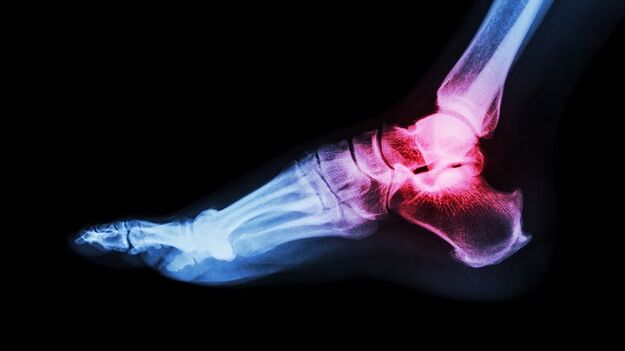
The ankle is often injured due to the large load to which it is exposed. Such a diagnosis as osteoarthritis of the ankle is not uncommon. It is placed regardless of the age and sex of the patient. What is ankle osteoarthritis and how can it be treated?
What is it?
There is a huge load on the ankle. Its function is to keep the body upright. Thanks to him, the person walks and runs. With a violation of the ankle system, it is extremely difficult to lead a familiar lifestyle. What interferes with the work of the ankle?
Ankle osteoarthritis, what is it? This is a chronic joint disease characterized by a degenerative course. Irreversible processes are triggered in the cartilage of the joint, which lead to terrible complications.
Ankle osteoarthritis develops gradually. Healthy joint surfaces are elastic and smooth. They provide cushioning under heavy loads and smooth gliding while driving. With pathology comes a disorder of tissue trophism and metabolism. The joint surface becomes inelastic and rough. During movement the cartilages come into contact with each other, leading to inflammation. When lifting weights, the main load falls on the bone, which threatens degenerative disorders.
Lack of treatment leads to more serious disorders. In 3-4 phases, cartilage and tissue damage is observed. Sons lit up. The joint becomes unstable. Support function violated. All these injuries as a whole lead to the fact that movement becomes impossible.
Osteoarthritis (osteoarthritis) is one of the most common joint diseases affecting a fairly large number of people.
Causes and risk factors
What is ankle osteoarthritis, we have solved. We will now find out what its cause is. Osteoarthritis of the ankle is considered a pathology of old age. This is due to age-related changes in the body. The cartilage becomes thinner, the bones become unstable and brittle. However, in the last ten years, the diagnosis of ankle osteoarthritis has become much younger. Such statistics are disappointing, as many patients ignore the first signs of the disease. Late diagnosis always threatens the development of serious complications.
Challenging factors include:
- dislocations;
- bruises;
- inflammatory diseases;
- injury;
- extra pounds;
- impaired metabolism;
- unbearable physical activity;
- wearing uncomfortable shoes;
- autoimmune and endocrine diseases;
- osteochondrosis.
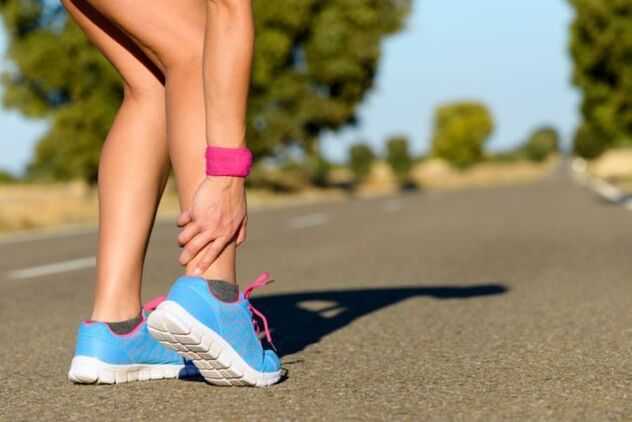
Clinical symptoms
Ankle osteoarthritis is recognized by the following features:
- Pain. It is mild at first and appears after walking or physical exertion. Sometimes when a person is in an awkward position. As the pathological process progresses, the pain syndrome intensifies and worries at rest.
- Swelling and inflammation. These signs appear in the background of injuries and sprains. Body temperature in the affected area rises.
- Click. When the ankle is affected, the click is "dry" and causes an attack of pain.
- Dislocation or subluxation. Due to the thinning and decomposition of the cartilaginous tissue, the joint becomes unstable. The bones can move and fall out of the joint capsule. These changes cause attacks of acute pain.
- Joint stiffness. When cartilage tissue is replaced, the bone joint stops functioning normally, which negatively affects its mobility.
- Joint deformity. The symptom occurs in 3-4 stages of osteoarthritis. Osteophytes also lead to ankle curvature.
If one of the symptoms occurs, it is recommended to see a doctor immediately. Timely treatment is a step towards recovery.
Osteoarthritis of the joints of the feet and ankles is characterized by slow progression with the gradual development of clinical manifestations over several years.
Classification and phases
The disease developed in different ways. In some patients it takes several years from the first signs to the final stage, in others the rapid development of the disease is noticed. The speed depends on the age and health condition of the patient, the time of the beginning of the therapy. The symptoms of ankle osteoarthritis become lighter as the disease progresses.
There are four stages of osteoarthritis:
- The first stage is often unnoticed. Sometimes, after strenuous exertion, morning stiffness and pain in the ankle occur. When the foot moves, a characteristic crunch is heard. Pathological changes are not yet visible on X-rays, but the destructive process of cartilage has already begun.
- Morning stiffness becomes prolonged. It takes 20-30 minutes for the leg to develop. Sometimes lameness occurs. Osteoarthritis of the second degree of the ankle joint is recognized on the radiograph by the growth of bone tissue, bone displacement.
- Symptoms in 3 stages are pronounced. The pain no longer worries only after a heavy load, but also at rest. It is difficult for the patient without painkillers. Lameness increases. Crutches may be needed. The damaged joint is swollen and deformed. The ankle muscles atrophy. X-rays show narrowing of the joint space, formation of osteophytes, subluxation.
- Phase 4 is the most difficult. It develops as a result of lack of treatment. The cartilage is destroyed, the surfaces of the joints are joined. Walking is no longer possible.
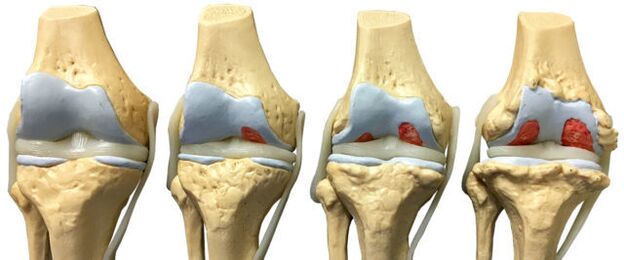
With the development of osteoarthritis of the ankle, there is a gradual change in the cartilage and bone tissue of the joint surfaces.
Diagnosis
The diagnosis of ankle osteoarthritis is based on clinical symptoms and data obtained during the examination. Laboratory studies are considered ineffective because there are no specific tests that can detect pathology. In the period of remission, all indicators are within normal limits, with the worsening of the disease, a clinical blood test will show high levels of C-reactive protein and ESR. These indicators indicate that the pathological process has already begun.
Instrumental methods are used to confirm the diagnosis:
- radiograph;
- Magnetic resonance imaging;
- Ultrasound;
- bone scintigraphy;
- diagnostic joint puncture.
Simple radiography
Simple radiography is the most reliable and most effective method for diagnosing diseases that occur in the musculoskeletal system. The principle of manipulation is the different absorption of X-rays by muscle tissues. Soft tissues transmit X-rays, but hard tissues absorb them. An X-ray allows you to diagnose the disease itself and its consequences.
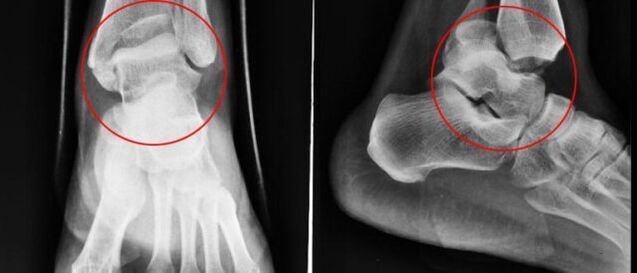
Conventional radiography is a method of examination in which a small amount of X-rays is transmitted through a person’s body or part of a person’s body.
The clip allows you to see:
- The condition of bone surfaces in articulation.
- The shape, size and arrangement of the structures in the joint are relative to each other.
- Fabric condition.
- The size of the common space.
These indicators help the doctor determine the type and extent of joint damage. If the data are not enough, then doctors prescribe other studies.
In osteoarthritis of the ankle, X-rays are performed in three projections:
- side;
- back;
- back with the leg moved inward.
The disease is characterized by the following changes:
- reduction of joint space;
- the presence of osteophytes;
- bone cartilage replacement (subchondral sclerosis);
- smaller gaps in the periarticular part.
Nuclear magnetic resonance
Nuclear magnetic resonance imaging (NMR) as a diagnostic method allows you to study those parts of the body where there is water. The image shows the bones are dark in color because they contain less water, but the muscle tissue, discs, and nerves are lighter. MRI allows you to detect the slightest changes in the structure of bone tissue and joints. The study is also prescribed to patients before joint prosthetics. YMG has a drawback - a high price.

In nuclear magnetic resonance, a change in the properties of hydrogen molecules under the influence of a strong magnetic field is recorded.
Magnetic resonance imaging
Magnetic resonance imaging (MRI) is an alternative diagnostic method that allows you to carefully examine the ligament structure of joint, muscle and cartilage tissue. With the help of magnetic resonance imaging, the doctor assesses the condition of the lower leg joints. Based on research data, the pathology is detected at an early stage of development.
The diagnostic principle is based on exposure to radio waves and strong magnetic radiation. The magnetic field used is not dangerous and does not pose a health hazard.
MRI is contraindicated in case of mental disorders, during pregnancy and the presence of metal objects in the human body.
When diagnosing ankle osteoarthritis, classic (closed-type) magnetic resonance imaging devices are used, because they have better image quality. An MRI machine is a large, cylindrical tube with a magnet around it. The patient lies on a special table. The ankle is fixed with a special coil. The procedure takes 30-40 minutes. The study is absolutely painless. Patients may feel warmth in the lower leg area.
Ultrasound
Ultrasound examination has been widely used in medicine since the 1990s. This technique has shown itself well in making accurate diagnoses. An ultrasound scan is also performed due to ankle osteoarthritis.
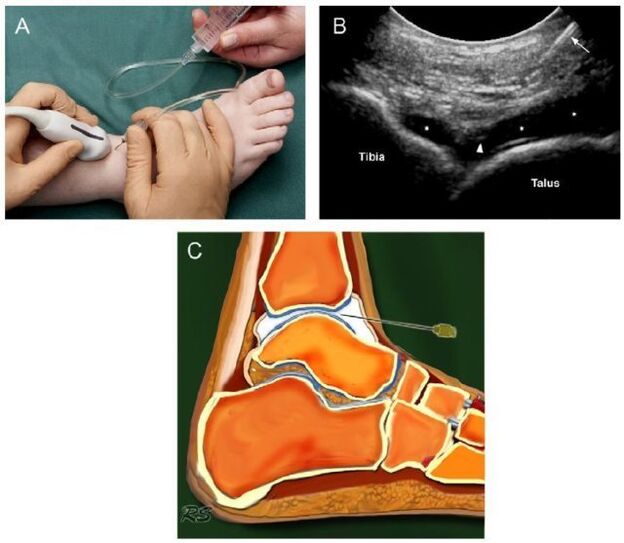
Today, ultrasound examination is not of special importance in the diagnosis of osteoarthritis, because it does not allow a sufficiently good study of damaged joints.
The device with which the research is conducted produces waves at ultrafrequencies. The waves bounce off the tissue and are recorded on a monitor. Based on the obtained image, the doctor determines the type of pathology. To make the image on the monitor clear, a special gel is used. Removes air gaps and gives the sensor better glide.
Ultrasound examination does not harm the patient, so the procedure can be repeated several times. The advantages of ultrasound also include low cost and high accuracy.
The following indicators are a clear sign of osteoarthritis:
- cartilage thinning;
- the presence of bony outgrowths;
- accumulation of effusion in the joint cavity (synovitis);
- loss of cartilage space.
Bone scintigraphy
Scintigraphy is a highly accurate study that can detect pathological changes in bone using isotopes. Doctors divide pathogenic foci into "cold" and "hot". In the first case, we are talking about zones in which there are no isotopes. These areas are poorly supplied with blood and are not visible during the scan. "Cold" areas are places that are affected by malignant tumors. In "hot" areas, isotopes accumulate quickly and appear very bright when scanned. Such areas indicate the presence of inflammatory processes.
The role of scintigraphy in arthrosis is significant. The study helps to distinguish arthrosis from a number of other diseases when the clinical symptoms are extremely similar.
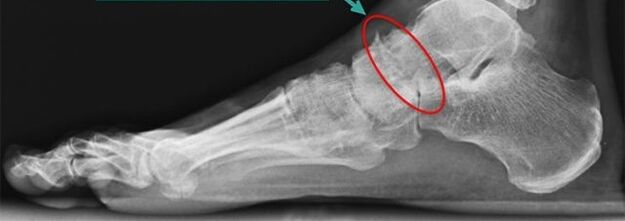
During the scintigraphy of the bones, a special preparation containing special marked atoms is injected into the body.
Based on the results of the scintigraphy, the doctor gives a clinical prognosis and determines the treatment regimen. The only drawback of the study is the high cost. Scintigraphy is performed using special equipment and, unfortunately, not all medical institutions can afford it.
Although radioactive scanning is a safe procedure, it still has a number of contraindications:
- pregnancy;
- lactation period;
- taking barium-containing medications.
When injecting a radioactive substance, some patients experience an allergic reaction in the form of itching and rash. These side effects do not cause danger and disappear on their own in a short time.
Joint puncture
A joint puncture is a diagnostic procedure in which a needle is inserted into the joint cavity to collect synovial fluid. This fluid is then sent for further research. Based on the obtained data, the doctor makes a conclusion about the nature of the disease and the stage of its development.
At first glance, a sting is a simple procedure, but it is not. Extracting fluid from the joint capsule requires extreme precision of the doctor’s movements. Sons is very thin and one awkward movement traumatizes him. As a result, an inflammatory process developed. Potential risks include infection. It is not difficult to introduce the infection into the joint capsule through poorly sterilized instruments.
The manipulation technique is different for each joint. When collecting articular exudate from the ankle, puncture is performed anteriorly, between the outer ankle and the extensor tendon of the digitorum longus.
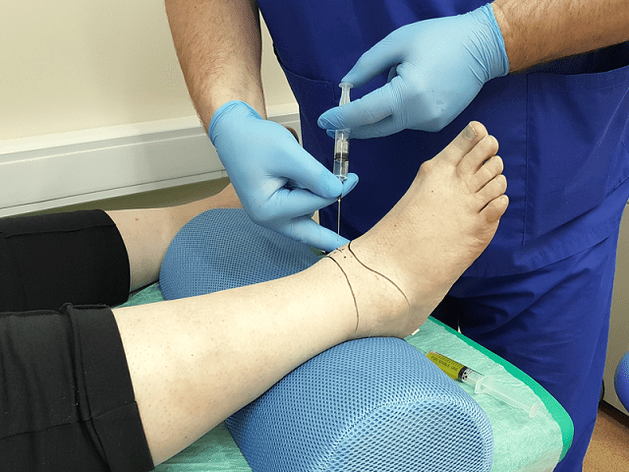
Diagnostic sampling of intra-articular fluid allows laboratory analysis and excludes inflammatory arthritis.
Basic principles of treatment
Once the diagnosis of ankle osteoarthritis is confirmed, the symptoms will not wait long. Treatment begins immediately. Further prognosis depends on a well-chosen treatment regimen and the timeliness of onset.
Osteoarthritis is an insidious disease. It cannot be completely cured. The goal of therapy is to stop degenerative processes and prolong the period of remission. For this purpose, doctors prescribe medication, physiotherapy, massage, therapeutic gymnastics and folk remedies. If all the conditions are met, it is possible to count on positive dynamics, otherwise the disease progresses.
Osteoarthritis drug therapy
Depending on the therapeutic effect, drugs are divided into several groups:
- Anti-inflammatory or pain medications. This group of drugs aims to remove the focus of inflammation and relieve pain. The earlier anti-inflammatory therapy is started, the better the chances of saving the joint. Drugs from this group can be produced in the form of tablets and ointments.
- Glucocorticoids. These drugs are prescribed when the above remedies are ineffective. They are produced in the form of a solution for injection. The drug is injected directly into the joint.
- Chondroprotectors. Designed to slow cartilage destruction.
The treatment regimen and dose are chosen by the physician depending on the severity of the symptoms, the age of the patient, the presence of comorbidities, and other factors. Self-medication is dangerous and often worsens the situation, because many drugs have a number of side effects and have their own contraindications.

Features of radical treatment
If conservative therapy fails, doctors are forced to resort to a radical method of treatment (surgical intervention). The operation is also displayed when:
- secondary (posttraumatic) and primary arthrosis of 3-4 degrees;
- arthrosis with complications;
- constant and severe pain in the ankle, radiating to the knee;
- severe lameness;
- paresis and paralysis of the leg muscles;
- violation of flexion-extensor function of the joint;
- injury to the supporting ability of the foot.
Surgical intervention is contraindicated if:
- the patient is younger than 12 years;
- fistulas are located in the joint;
- the patient has had diabetes mellitus in the past, heart failure;
- Infectious diseases were found in the area of the proposed intervention.
Traditional treatment
Doctors believe that the treatment of osteoarthritis should be carried out only under the supervision of specialists, but do not deny the positive effect of folk remedies. Alternative medicine acts as an effective prophylaxis that helps eliminate symptoms and maintain remission.
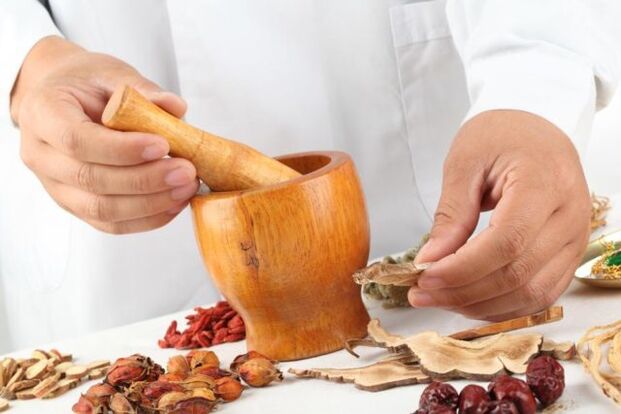
Folk remedies are quite symptomatic treatment of osteoarthritis of the foot.
Treatment at home should be coordinated with your doctor to avoid side effects and complications.
Traditional healers suggest treating ankle osteoarthritis with:
- Velcro. Wash burdock leaves with soap and running water. Apply the leaves with the soft side on the skin. Fix the top with a bandage or cling film. It is better to keep the compress on all night.
- They are marine. Chop the salt in the pan. Pour it into a canvas bag and fasten it to the ankle. Hold the bag until the salt has cooled. The heat relieves the pain. Instead of salt, sand, lentils and buckwheat are also used.
- Lilacs. Pour triple cologne over the lilac flowers. Leave the tincture to stand in a dark and cool place for 10-14 days. Rub the affected area in the morning and evening.
- Egg shell. Grind the mussels in a coffee grinder. Take the obtained powder for ½ teaspoons. before meals.
Remember that treatment with folk remedies should not be the only measure. Complex treatment includes medication, exercise therapy, massage, physiotherapy, spa treatment. In advanced cases, doctors resort to radical measures - surgical intervention.
Surgery
The following types of operations are used for arthrosis of the feet in medicine:
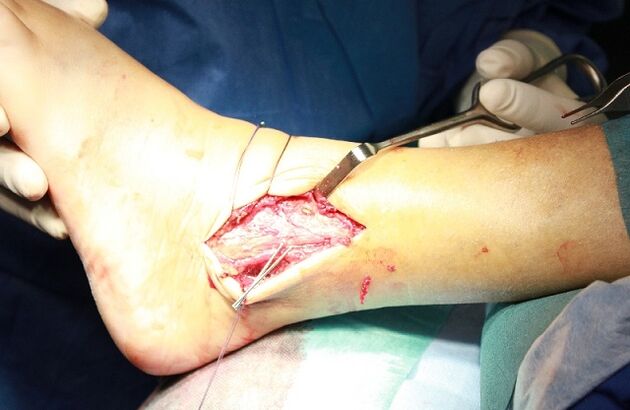
- joint arthrodesis;
- joint arthroscopy;
- endoprosthetics.
Arthrodesis is an operation to immobilize a joint. It is performed to restore some of the lost support ability. The only disadvantage of the operation is that the bones (tibia and talus) grow together, which leads to immobility. Arthrodesis is rarely used in medical practice.
Arthroscopy is a minimally invasive procedure. During the operation, the doctor makes small incisions in the area of the joint and inserts an arthroscope through them (a special tube at the end of which a camera is installed). With his help, the surgeon carefully examines and assesses the condition of the intra-articular structures. If necessary, pieces of the damaged joint or blood clots are removed from the synovial fluid. This manipulation is less traumatic. The only disadvantage of arthroscopy is the high risk of recurrence.
Endoprosthetics is the last resort. It is performed with advanced osteoarthritis. Endoprosthetics allow you to partially or completely replace the affected joint. Innovative prostheses with modernized mechanics are used as a prosthetic product. The artificial joint lasts from 10 to 20 years.
Power characteristics
In order to achieve a favorable result, drug treatment is supplemented by dietary therapy. Nutritionists have developed a special diet to avoid aggravation of the disease, and at the same time supply the body with all the necessary vitamins and nutrients. Diet for overweight patients plays a special role. Since obesity is one of the reasons for the development of osteoarthritis, weight correction is an integral part of treatment.

The patient should reconsider his habits in everyday life, which contribute to and cause the progression of arthrosis of the feet.
Nutritionists recommend following the following dietary conditions:
- Eat often and in small portions.
- Drink at least 2 liters of fluid a day.
- Give up sweets and salt.
- The last meal is no later than 18. 00.
- Dishes are allowed to steam, cook or bake.
The main task of the diet for osteoarthritis is a balanced and enhanced diet. Fasting is out of the question. A strict diet and body cleansing do more harm than good. Calcium is expelled from the body, which is needed for cartilage regeneration. A nutritionist will help you put together a daily diet.
With osteoarthritis it is allowed to eat cereals, pasta, dairy products, cheese, legumes, vegetables, fruits, rye bread, dried fruits, nuts, fish, poultry. Heavy and fatty side dishes, foods containing colors and flavors, as well as pickles, marinades, smoked meats, fatty soups, pastries, spices, sauces, chocolate, ice cream, coffee and alcohol are prohibited.
Prevention of osteoarthritis
To avoid the development of osteoarthritis of the ankle, doctors recommend taking preventive measures:
- wear comfortable shoes without heels;
- stick to a diet and drink plenty of fluids;
- seasonally take vitamin and mineral complexes;
- swimming;
- walk more in the fresh air;
- remove excessive stress on the legs;
- avoid hypothermia;
- see a doctor in a timely manner.
With existing osteoarthritis, it is recommended to correct the lifestyle:
- Rejecting bad habits. They have been proven to cause blood stagnation in the tissues and accelerate the destruction of cartilage.
- Perform a series of ankle warm-up exercises.
Forecast
Osteoarthritis is a progressive disease. Without treatment it leads to irreversible consequences and complete immobility of the joint. Early diagnosis of pathology allows you to work without radical measures. Medications can stop the pathological process and alleviate the patient's condition. The fight against the disease in the early stages is without complications.



































